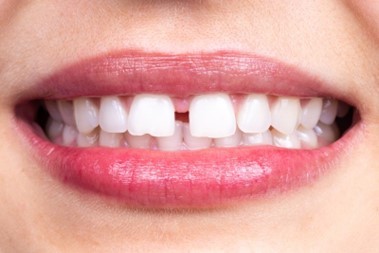
A frequent concern that many individuals face is the presence of a gap between their front teeth, a condition referred to as diastema. This gap can sometimes impact one’s self-assurance and overall self-esteem. The good news is that cosmetic dentists offer a range of treatments to address this issue, which encompass dental bonding, veneers, and orthodontic interventions. These treatments are not only safe and effective but also yield enduring results. Read on as we will explore how a cosmetic dentist can determine the optimal solution for you.
6 Causes of a Diastema?
A diastema refers to a noticeable gap, typically exceeding 0.5 millimeters, that can develop between any two adjacent teeth. While it’s a common occurrence among children, there is no guarantee that it will naturally close over time. Multiple factors can contribute to the formation of this gap, including:
- Tooth loss – Particularly, the loss of primary (baby) teeth can create a gap between the two front teeth.
- Untreated gum disease – This gum infection can result in a gap between teeth due to gum recession, tooth shifting, or tooth loss.
- Incorrect swallowing reflex – An incorrect swallowing reflex can exert pressure on the front teeth, gradually causing them to separate and create a gap.
- Labial frenum – The tissue extending from the upper lip to the gums above the upper front teeth, known as the labial frenum, can lead to an enlarged gap between the two front teeth.
- Poor oral habits – These encompass smoking and the habit of biting into hard objects.
- Tooth size – The size of the teeth relative to the jaw, which includes missing or undersized teeth, can also contribute to the development of a diastema.
How Are Diastemas Treated?
Detecting a diastema is usually straightforward and can be accomplished during a routine dental examination. Treatment isn’t always necessary, particularly when it results from natural factors such as jawbone size or the loss of baby teeth. While a diastema may not always demand treatment, leaving it unaddressed can elevate the risk of plaque accumulation, enamel erosion, and even gum disease.
The treatment options for diastemas encompass the use of braces, veneers, or dental bonding. The selection of the most suitable treatment is contingent upon the unique circumstances of each patient. While Invisalign stands as a widely employed orthodontic solution, veneers and dental bonding are equally effective alternatives to address diastemas.
In cases where the diastema arises from missing teeth, more intricate solutions such as dental bridges, dentures, or implants may be warranted. For situations linked to gum disease, periodontal therapy is the recommended approach. In instances where an oversized labial frenum is the underlying issue, surgical intervention becomes necessary.
About the Practice
Dr. Michael C. Byars, a highly skilled dentist, takes immense pride in utilizing his expertise to instill confidence in his patients’ smiles. Dr. Byars leads a seasoned team of dentists and specialists who are deeply committed to delivering individualized care and identifying the most suitable solutions for each patient’s specific requirements. In addition to regular checkups and responsive emergency dental care, their services encompass treatments for closing gaps between teeth, such as braces, dental bonding, and veneers, as well as more advanced procedures like bridges and implants. To schedule an appointment or to explore their services, reach Dr. Byars’ office at (816) 781-8222 or visit his website.

